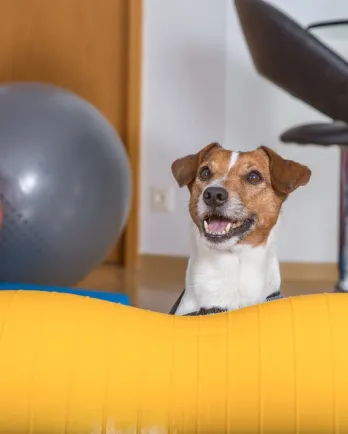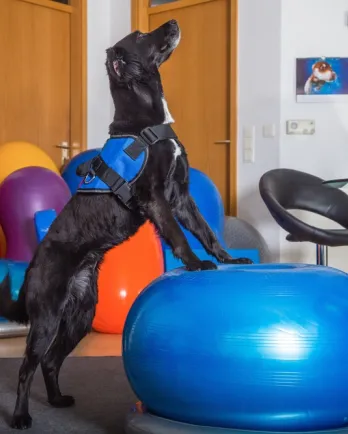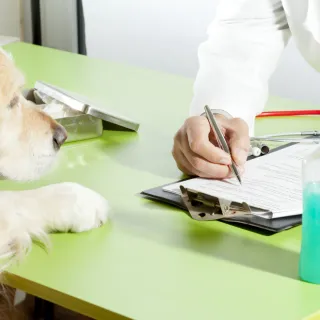Physical Therapy for Senior Dogs by Martha Pease
This post contains excerpts from the article "Physical Therapy for the Senior Dog" by Martha Pease, CCRP, MSPT. The entire article can be read in the book Your Dog's Golden Years – Manual for Senior Dog Care, edited by Jennifer Kachnic.
As a dog gets older and a little stiffer when getting up and moving around, owners often start to wonder what options exist to help their pet. Physical therapy, also called “canine rehabilitation,” is one way to help older dogs stay active and mobile. Any human condition helped by physical therapy also applies to dogs. The approach is different, but the principles are very much the same.
For the geriatric dog, physical therapy goals include pain control, maintaining range of motion and flexibility and maintaining or improving strength, therefore helping the dog stay as active as possible. When a dog experiences less pain, he is better able to climb stairs, get up from the floor or jump on the couch. A therapist’s overall goal is to improve the animal’s ability to maneuver in the house, participate in sporting activities, position to urinate and defecate, go for a walk and function in other ways. With physical therapy, the dog may live longer and have an improved quality of life in its later years.
Before the dog sees a canine rehabilitation practitioner, it is very important that a veterinarian examine the pet to rule out and/or treat other possible medical conditions. Some health issues, such as infection or cancer, can mimic musculoskeletal problems.
What to Expect from a Physical Therapy Evaluation
Physical therapists are biomechanics specialists. They assess the musculoskeletal and nervous systems for any issues that might be contributing to the dog’s functional difficulties. The evaluation is the pivotal step in determining the dog’s rehabilitation activities and assessing subsequent improvements and changes. The evaluation consists of: getting medical information from the veterinarian; obtaining the dog’s history from the owner; observing the dog’s mobility and gait; assessing the animal’s range of motion, strength and neurological deficits, and palpating to discover areas of pain, tenderness, tightness, muscle atrophy and swelling.
The dog’s history is very important, particularly for the senior animal:
How long has the problem been going on? The answer to this helps determine if the condition is acute or chronic and enables the practitioner to make a prognosis for the extent of recovery.
What has the owner observed regarding the problem? He or she might mention the dog’s difficulty getting up the stairs; the dog may be either hesitant, walks with bunny hops, needs momentum or requires help. This gives a picture of the extent of the dog’s weakness and creates milestones by which to measure progress.
Another very important piece of information is how the owner perceives pain in the dog.
- Does the dog hide more?
- Avoid playing with other dogs?
- Become grumpy with other dogs?
- Has the dog stopped greeting the owner at the door?
These are all indications that a dog is in distress.
In the next portion of the evaluation, the practitioner will observe how the dog moves. For example,
- Does the dog struggle to get up, using mostly the front legs?
- Is the dog limping?
- Is the animal’s coordination abnormal?
- Does the dog stand comfortably or is all the weight on the front legs? Or does it pick up a leg?
These can be indications of pain or weakness. Limping can be from discomfort or weakness and lack of trust in the leg. Using front legs to get up or shifting weight forward is indicative of rear leg pain or lack of strength. Impaired coordination usually implies an underlying neurological problem. After this, the hands-on examination begins.
- What is the quality of the muscling?
- Is there muscle atrophy?
- Is there tenderness?
- Do some of the joints feel thickened, have palpable boney changes or seem tender or swollen?
- What is the range of motion of each joint?
- Is there any ligamentous laxity?
Ligaments are like leather straps that hold the bones in place. If they are injured or stretched out, there is too much wiggle in the join. The therapist will also assess the spine for flexibility and joint mobility of the vertebra as well as tenderness along the spinal muscles. The practitioner will also test the dog’s reflexes to see if they indicate any neurological abnormalities.
Treatment Plan
After the practitioner thoroughly examines the dog, all the information from the veterinarian, the owner and the physical examination are put together to determine the main problem within the musculoskeletal system that is affecting the dog’s ability to move and function. A treatment plan is designed to meet that dog’s needs and will include instruction for both home and in-clinic care.
A home exercise program may include light massage, gentle stretches and range-of-motion exercises for joint health, and simple strengthening exercises. Often, a very important component of the home program is leash walks. Regular walks, even if they are very short, are critical. The older dog often is less active and, therefore, gets weaker. This becomes a vicious cycle. Walks encourage the dog to move and help maintain strength. Daily outings keep the dog mentally engaged, especially if the dog enjoys walks. Regular exercise is beneficial for organ health, as well.
In the clinic, treatment varies based on what equipment each clinic has and what that practitioner has found the most helpful. In-clinic treatments may include massage, stretching, cold laser, ultrasound, electrical stimulation, acupuncture, strength and coordination exercises, and hydrotherapy.
Hydrotherapy
Hydrotherapy includes exercise on an underwater treadmill, as well as swimming, and is particularly helpful. It has many benefits for all dogs, but can have an especially dramatic effect on senior dogs, providing a painless, fun means of exercise and movement. Why does hydrotherapy work so well? The reason is relatively simple: The water provides buoyancy, which diminishes the stress on the joints, allowing the dog to move without pain. When swimming, the dog moves his legs in a different manner than walking during treatment, which results in more range of motion and stretching of the joints and muscles. The water also offers resistance for muscle strengthening.
For the weak or the neurologically impaired dog that can’t support itself against gravity, water exercise is liberating. With swimming, the dog can move without falling or having to hold himself up. Its muscles are used differently than on land, which can help with coordination and cross training. Cross training is helpful because the muscles are used in a different way than on land which helps with neuromuscular retraining and stretching soft tissues. While in the water, the practitioner can stimulate movement and work with patterning to retrain correct limb usage.
Physical therapy for older dogs is often an ongoing program. Regular sessions help maintain the dog’s status. The frequency of the sessions depends on the effectiveness of the program and the practitioner’s preference.
In summation, physical therapy and hydrotherapy in particular, has been shown to benefit older dogs. The overall result is improved quality of life and often a longer life, as well.
You can find the full article and many more great articles about senior dog care in Your Dog's Golden Years, edited by Jennifer Kachnic.
The information presented by The Grey Muzzle Organization is for informational purposes only. Readers are urged to consult with a licensed veterinarian for issues relating to their pet's health or well-being or prior to implementing any treatment.
The Grey Muzzle Organization improves the lives of at-risk senior dogs by providing funding and resources to animal shelters, rescue organizations, sanctuaries, and other nonprofit groups nationwide.
About the Contributor: Martha C. Pease, CCRP, MSPT received her physical therapy Masters from Columbia University in 1982 and worked for over 20 years as a human physical therapist. In 1999, she began treating dogs and is one of the first to receive the certification in canine rehabilitation from the University of Tennessee. Ms. Pease was recognized by the American Physical Therapy Association as an orthopedic. She has also taught seminars on aquatic therapy for the Canine Rehabilitation Institute and AHHA.




